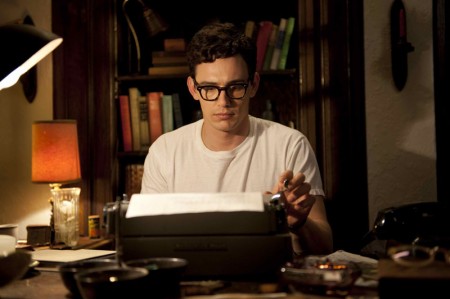
James Franco stars as Allen Ginsberg in the Oscilloscope Laboratories film “Howl.” Photo courtesy of Oscilloscope Laboratories
More than 50 years after Allen Ginsberg released his generation defining poem, “Howl,” James Franco has stepped up to define how Generation Y will remember the iconic Beat poet.
With “Howl,” Franco proves he has the chops to be a leading man, as he stars as the counter-culture’s outspoken literary hero.
Without much material to work with—Franco simply rehashes interviews with Ginsberg and emulates Ginsberg’s own reading of “Howl”— Franco shows he has the art of imitation down to a tee. In tonality, mannerism and appearance, Franco truly comes to life as Ginsberg.
The film is comprised of three interwoven scenes: Ginsberg’s first reading of “Howl” in 1955 at the Six Gallery in San Francisco, an interview with Ginsberg, recreated from various interviews with the poet, and the obscenity trial of the same year, where Lawrence Ferlinghetti, the publisher of “Howl and Other Poems,” is on trial for distributing obscene material.
Written and directed by Rob Epstein and Jeffrey Friedman, the film chronicles the personal journeys that led Ginsberg to create his seminal work, but skims over some important characters.
Presumably for the sake of time, the film unfairly assumes viewers have a fair knowledge of the Beat Generation and reduces some of its best minds—namely Jack Kerouac and Neal Cassady—to background characters who are never fully developed. Peter Orlovsky (Aaron Tveit), Ginsberg’s longtime partner, also plays a miniscule role.
The film relies heavily on its courtroom scenes, which give the poem context and drive the movie’s plot forward.
Jon Hamm, who seems to be typecast as a handsome 1950’s smooth operator, plays defense attorney Jake Ehrlich. Suffice it to say, his courtroom speeches and cross-examinations are dramatic and perfectly delivered.
Jeff Daniels and Mary-Louise Parker also appear in the courtroom, as defense witness professor David Kirk and prosecution witness Gail Potter, respectively.
Shots of Franco reading “Howl” are black and white and interspersed with unusual interpretive animations of the poem by Eric Drooker.
Drooker, who did illustrative work for Ginsberg on Ginsberg’s 1988 book “Illuminated Poems,” misses the mark with his animations of “Howl.”
The drawings sometimes too literally try to portray abstract lines in Ginsberg’s work and look like trippy graphic novel pages in motion.
But if viewers can overlook the film’s wacky animations, they will walk about with a better understanding of the poem — and the man — who helped define a generation.
“Howl” is currently playing at the West End Cinema in Washington, D.C. Showtimes and ticket information can be found at www.westendcinema.com.






Comments